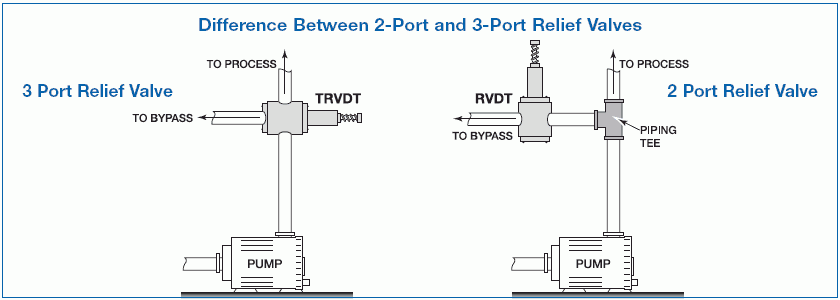 Tech Brief:
Tech Brief:
Differences Between a 2-Port Relief Valve and a 3-Port Relief Valve
Below right: the new Plast-O-Matic Series TRVDT 3-port design
 Advantages of a 2-Port Design:
Advantages of a 2-Port Design:
• 2-port relief valve can also be used as a backpressure regulator and an anti-siphon valve; 3-port cannot.
• Choice of in-line or angle pattern increases versatility in piping design.
• Flow capacity is better; 2-port valves provide less restriction and less deadleg.
Advantages of a 3-Port Design:
• Smaller "footprint" in a system.
• No need for additional piping tee.
• Easy replacement in existing systems using 3-port valve.
2-Port relief valves require a piping tee for by-pass and relief applications, but not for backpressure or anti-siphon applications. Unlike three-port style valves which are placed directly in-line and cause a drop in both pressure and flow, a valve "teed" off the line usually offers the best system design and ease of maintenance.
In most relief and by-pass applications, 3-port valves do not perform as well as 2-port valves installed on a tee. No 3-port relief valve is suitable for use as a backpressure regulator or anti-siphon valve, and no 3-port relief valve will deliver the flow and performance of a Plast-O-Matic 2-port relief valve.
The illustration below shows the essential differences between 2-port and 3-port relief valves; note the advantage of piping convenience in the 3-port installation compared to the advantage of unhindered flow in the main pipeline shown in the 2-port installation.

Some Helpful Links for this Tech Brief:
Series TRVDT 3-port Relief Valve
Series RVDT 2-port Relief Valve
Plast-O-Matic Valves, Inc.
1384 Pompton Avenue
Cedar Grove, NJ 07009 USA
Voice: (973) 256-3000
Fax: (973) 256-4745

Top of Page
Copyright © 2007 Plast-O-Matic Valves, Inc.

 Advantages of a 2-Port Design:
Advantages of a 2-Port Design: